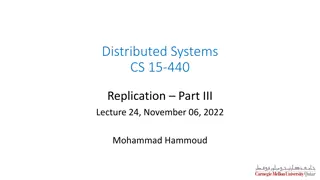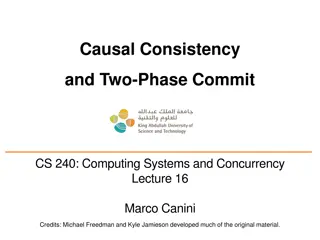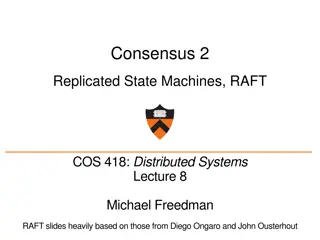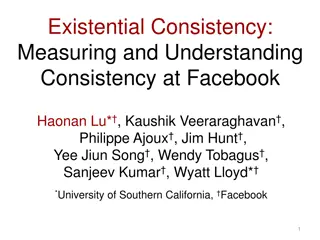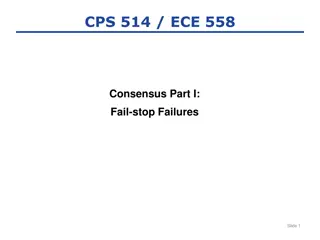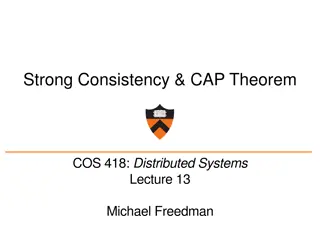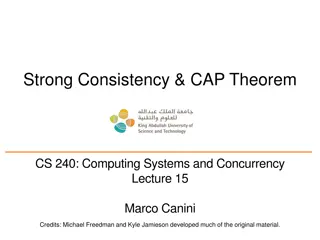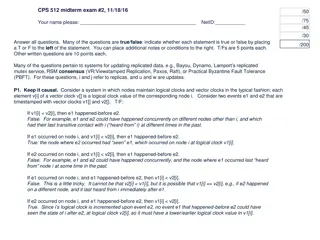Understanding Replication and Consistency in Computer Systems
Explore the concepts of replication and consistency in computer systems, discussing the benefits and challenges of using replicas for reliability, performance, and scalability. Learn about object replication problems and solutions, and the importance of maintaining consistency in shared data access.
Download Presentation

Please find below an Image/Link to download the presentation.
The content on the website is provided AS IS for your information and personal use only. It may not be sold, licensed, or shared on other websites without obtaining consent from the author. Download presentation by click this link. If you encounter any issues during the download, it is possible that the publisher has removed the file from their server.
E N D
Presentation Transcript
Replication and Consistency File System & I/O Background Using additional material and slides (further details can be found in Modern Operating Systems by Tanenbaum). Sprite Caching Example Consistency Models Replication and Consistency CS 2510, cs.pitt.edu 2
Replicas: why and why not? Reliability Tolerance to component failures Tolerance to corrupted data Performance Benefits scalability Allows for concurrent access to resources (data/objects/processors) Reduces the delay for geographically dispersed resources Disadvantages Cost of replications is high Maintaining consistency of multiple copies is tough Implementation is harder (e.g., different users have different needs of number of replicas and more or less accurate consistency models) It s very important to remember: consistency needs differ for different users/applications. Replication and Consistency CS 2510, cs.pitt.edu 3
Object Replication Problem: If objects (or data) are shared, we need to do something about concurrent accesses to guarantee state consistency. Replication and Consistency CS 2510, cs.pitt.edu 4
Object Replication solutions A remote object for which an object adapter is required to handle concurrent invocations A remote object capable of handling concurrent invocations on its own. Replication and Consistency CS 2510, cs.pitt.edu 5
Where in the world is Object Replication A distributed system responsible for replica management is more general and easier to implement A distributed system for replication-aware distributed objects is more customizable Replication and Consistency CS 2510, cs.pitt.edu 6
Performance, replication, scalability Main issue: To keep replicas consistent, we generally need to ensure that all conflicting operations are done in the the same order everywhere Conflicting operations (example from transactions): Read write conflict: a read operation and a write operation act concurrently Write write conflicts: two concurrent write operations Tradeoff: guaranteeing global ordering on conflicting operations may be a costly operation, downgrading scalability Solution: weaken consistency requirements so that hopefully global synchronization can be avoided This solution only lends itself to some applications, not all. Replication and Consistency CS 2510, cs.pitt.edu 7
Data-Centric Consistency Models (1) The general organization of a logical data store, physically distributed and replicated across multiple resources. Consistency model: a contract between a (distributed) data store and processes, in which the data store specifies precisely what the results of read and write operations are in the presence of concurrency. Processes agree or don t use it. Replication and Consistency CS 2510, cs.pitt.edu 8
Data-Centric Consistency Models (2) Strong consistency models: Operations on shared data are synchronized: Strict consistency (related to absolute global time) Sequential consistency (what we are used to) Causal consistency (maintains only causal relations) FIFO consistency (maintains only individual ordering) Weak consistency models: Synchronization occurs only when shared data is locked and unlocked: General weak consistency Release consistency (Eager & Lazy) Entry consistency Observation: The weaker the consistency model, the easier it is to build a scalable solution. Replication and Consistency CS 2510, cs.pitt.edu 9
Strict Consistency Any read to a shared data item X returns the value stored by the most recent write operation on X. A strictly consistent store. A store that is not strictly consistent. It may be expensive to maintain strict consistency Does everyone need it? Who does? How can it be better/easier/less costly? Note: Strict consistency is what you get in the normal uniprocessor, sequential case, where your program does not interfere with any other program. Replication and Consistency CS 2510, cs.pitt.edu 10
Sequential Consistency The result of any execution is the same as if the operations of all processes were executed in some sequential order, and the operations of each individual process appear in this sequence in the order specified by its program. A sequentially consistent store. A store that is not sequentially consistent. This is for interleaved executions: there is ONE total ordering for all operations Replication and Consistency CS 2510, cs.pitt.edu 11
Linearizability Sequential consistency + operations are ordered according to a global time. This may be more practical, since it assumes loosely synchronized clocks (Lamport clocks? NTP?) Since the definition of global time is loose, so is the consistency model. Therefore, linearizability is weaker than strict consistency, but stronger than sequential consistency. Happy medium. Replication and Consistency CS 2510, cs.pitt.edu 12
Casual Consistency (1) Events a and b are causally related if a causes or influences b. Events that are not causally-related are concurrent. Causal consistency: Writes that are potentially causally related must be seen by all processes in the same order. Concurrent writes may be seen in a different order on different machines. This sequence is allowed with a casually-consistent store, but not with sequentially or strictly consistency (what writes are concurrent?) Replication and Consistency CS 2510, cs.pitt.edu 13
Casual Consistency (2) A violation of a casually-consistent store. WHY? A correct sequence of events in a casually-consistent store. WHY? Replication and Consistency CS 2510, cs.pitt.edu 14
FIFO Consistency Writes done by a single process are seen by all other processes in the order in which they were issued, but writes from different processes may be seen in a different order by different processes. A valid sequence of events of FIFO consistency Is it valid for causal consistency? What about sequential consistency? Replication and Consistency CS 2510, cs.pitt.edu 15
FIFO Consistency Implementation is simple: Attach a PID+sequence# to each event Perform writes according to the this ordering Process P1 x = 1; if (y == 0) kill (P2); Process P2 y = 1; if (x == 0) kill (P1); Two concurrent processes. Unpredictable/illogical behavior? What s the problem? Replication and Consistency CS 2510, cs.pitt.edu 16
Summary of Consistency Models not using synchronization operations Consistency Description Strict Absolute time ordering of all shared accesses matters. All processes must see all shared accesses in the same order. Accesses are furthermore ordered according to a (nonunique) global timestamp Linearizability All processes see all shared accesses in the same order. Accesses are not ordered in time Sequential Causal All processes see causally-related shared accesses in the same order. All processes see writes from each other in the order they were used. Writes from different processes may not always be seen in that order FIFO Replication and Consistency CS 2510, cs.pitt.edu 17
Weak Consistency (1) Properties: Accesses to synchronization variables associated with a data store are sequentially consistent No operation on a synchronization variable is allowed to be performed until all previous writes have been completed everywhere No read or write operation on data items are allowed to be performed until all previous operations to synchronization variables have been performed. Implementation: use a synchronization phase Basic idea: You don t care that reads and writes of a series of operations are immediately known to other processes. You just want the effect of the series itself to be known. Replication and Consistency CS 2510, cs.pitt.edu 18
Weak Consistency (2) Observation: Weak consistency implies that we need to lock and unlock data (implicitly or not). A valid sequence of events for weak consistency. An invalid sequence for weak consistency. Replication and Consistency CS 2510, cs.pitt.edu 19
Release Consistency (1) Idea: Divide access to a synchronization variable into two parts Acquire phase: forces a requester to wait until the shared data can be accessed Release phase: sends requestor s local value to other servers in data store. Replication and Consistency CS 2510, cs.pitt.edu 20
Release Consistency (2) Rules: Before a read or write operation on shared data is performed, all previous acquires done by the process must have completed successfully. Before a release is allowed to be performed, all previous reads and writes by the process must have completed Accesses to synchronization variables are FIFO consistent (sequential consistency is not required). Replication and Consistency CS 2510, cs.pitt.edu 21
Entry Consistency (1) Conditions: An acquire access of a synchronization variable is not allowed to perform with respect to a process until all updates to the guarded shared data have been performed with respect to that process. Before an exclusive mode access to a synchronization variable by a process is allowed to perform with respect to that process, no other process may hold the synchronization variable, not even in nonexclusive mode. After an exclusive mode access to a synchronization variable has been performed, any other process's next nonexclusive mode access to that synchronization variable may not be performed until it has performed with respect to that variable's owner. Replication and Consistency CS 2510, cs.pitt.edu 22
Entry Consistency (2) With release consistency, all local updates are propagated to other copies/servers during release of shared data. With entry consistency, each shared data item is associated with a synchronization variable. When acquiring the synchronization variable, the most recent values of its associated shared data item are fetched. Note: Where release consistency affects all shared data, entry consistency affects only those shared data associated with a synchronization variable. Question: What would be a convenient way of making entry consistency more or less transparent to programmers? Replication and Consistency CS 2510, cs.pitt.edu 23
Entry Consistency (3) A valid event sequence for entry consistency. Replication and Consistency CS 2510, cs.pitt.edu 24
Summary of Consistency Models with synchronization operations Consistency Description Weak Shared data can be counted on to be consistent only after a synchronization is done Shared data are made consistent when a critical region is exited Release Entry Shared data pertaining to a critical region are made consistent when a critical region is entered. Replication and Consistency CS 2510, cs.pitt.edu 25
Summary of Consistency Models Consistency Description Strict Absolute time ordering of all shared accesses matters. All processes must see all shared accesses in the same order. Accesses are furthermore ordered according to a (nonunique) global timestamp Linearizability Sequential All processes see all shared accesses in the same order. Accesses are not ordered in time Causal All processes see causally-related shared accesses in the same order. All processes see writes from each other in the order they were used. Writes from different processes may not always be seen in that order FIFO Consistency models not using synchronization operations (a) Consistency Description Weak Shared data can be counted on to be consistent only after a synchronization is done Release Shared data are made consistent when a critical region is exited Entry Shared data pertaining to a critical region are made consistent when a critical region is entered. Models with synchronization operations. (b) Replication and Consistency CS 2510, cs.pitt.edu 26



